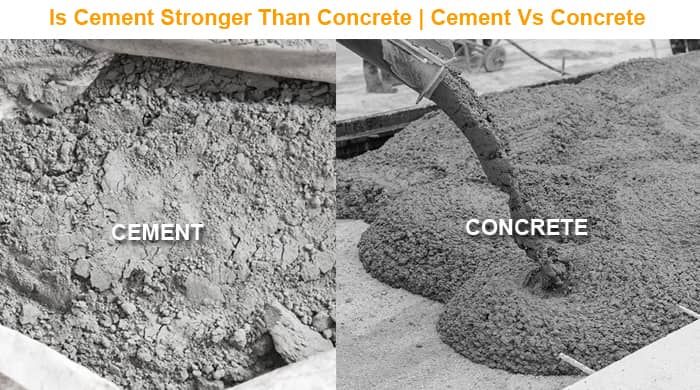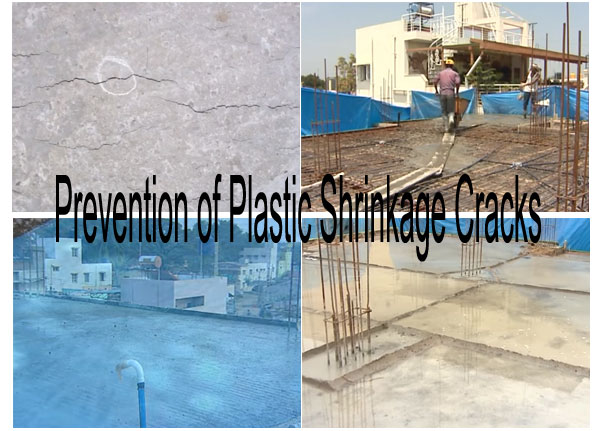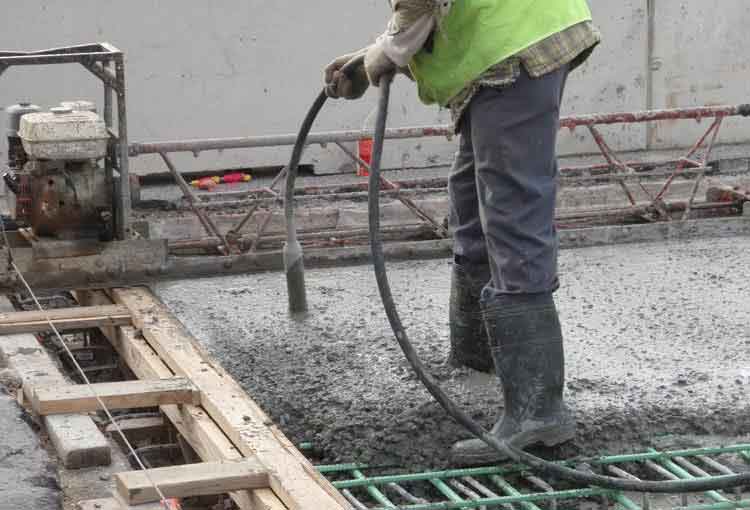Cement Vs Concrete | Concrete and Cement Differences
Cement and concrete are not interchangeable terms. Despite the fact that the terms are frequently and incorrectly used interchangeably. In order to make concrete, sand, stone, and cement are combined with water. When making concrete, cement is a crucial component. However, the materials are different. When water and cement combine, a gooey slurry is produced that combines with sand and stone to produce concrete. After drying out and curing, it becomes extremely powerful and rock-hard.
Imagining baking a cake helps. Cement is the flour and concrete is the cake. You couldn’t bake cake without flour.
However, cake and flour are not the same thing. Additionally crucial components, sand and stone would function similarly to sugar and eggs in this comparison.
Calcium, silicon, aluminum, iron, and other materials are combined chemically under controlled conditions to create cement. These components are burnt to an extreme temperature in a kiln to create clinker, which is subsequently pulverized into the fine, white powder we know as cement.
Cement has extremely few uses by itself. It is a hydraulic substance that, when combined with water, activates to create a gooey paste. Cement hardens and solidifies when it dries. A binder used to build other materials is cement. such as concrete, mortar, and grout.
Despite being one of the main components required to manufacture concrete, cement and concrete are not the same. Because it also includes stone and sand, concrete is a fairly durable substance. However, cement on its own is fairly frail and prone to cracking. Sand and stone are necessary to give it durability and strength.
In this post, we’ll examine the similarities and differences between concrete and cement as well as the appropriate applications for each.

Concrete & Cement Differences:
- Cement and concrete are not the same product, despite the frequent confusion between the two words.
- One of the most crucial components in the creation of concrete and other masonry goods like grout and mortar is cement. However, it isn’t frequently used by itself. This is so that it doesn’t crack or become weak without the addition of other ingredients.
- To produce something new, cement is used as an adhesive to join different materials, such as:
- The result of mixing it with sand is grout.
- To make mortar, which is more durable than grout, combine it with sand and lime.
- Concrete is produced by mixing cement, sand, and stone.
- Water is the final and most crucial element since it activates the cement. You would only have a mixture of ineffective dry materials without water. But a chemical reaction happens when those components are combined with water. The elements are joined together by the cement, which changes into a gooey paste. The strength and durability of the other elements are permanently added to the cement mixture when it later dries and hardens.
- A substance used to create other materials is cement. Cement is weak and prone to fracture on its own. One of the materials made using cement is concrete. Because sand and stone are present, it is incredibly sturdy and long-lasting.
- The concrete that makes up the modern world. Concrete is used to build foundations, driveways, roads, bridges, dams, buildings, etc. because it is robust and long-lasting. And without cement, that concrete would not be feasible.
The Fundamentals Of Concrete
Sand cement, stone, and water are the ingredients in concrete. One of the most frequently used building materials worldwide, it is employed in both residential and commercial as well as industrial construction. It’s simple to manufacture and use, incredibly robust, long-lasting, weatherproof, adaptable, and extremely reasonably priced.
Concrete’s strength can be changed by adjusting the proportions of the materials used in the mix. A simple 1:2:3 ratio, for instance, denotes 1 component cement, 2 parts sand, and 3 parts stone. A 4000 psi concrete is the end outcome.
Compressive strength is measured in pounds per square inch (PSI). Consequently, 4000 lbs. per square inch can be supported by concrete without it cracking.
It is common practice to mix and order concrete by the cubic yard, which is a volume measurement rather than a weight. An imagined cube that is 3 feet wide, 3 feet long, and 3 feet tall would be filled with a cubic yard of concrete. It can be purchased in bags, mixed on-site by you, or delivered by a concrete truck.
Concrete should only be mixed with very clean substances. The mixture can be changed by any organic item that is present in the stone, sand, or water. The water ought to be pure and devoid of any impurities, salt, or chemicals.
- Made of water and cement, stone, and sand.
- Water needs to be pure and new.
- The aggregate materials ought to be immaculately clean and contaminant-free.
- Extremely robust and long-lasting.
- Will solidify inside the shape of the container it is poured into.
Concrete is a flexible building material that may be poured into any shape and will dry in that shape. This is how walls composed of poured concrete, countertops, statues, footings, and foundations are constructed.
The Fundamentals Of Cement
Iron, aluminum, silicon, calcium, and other materials are used to make cement, which is a binding ingredient. Limestone, shells, chalk, clay, iron ore, and silica sand all contain those elements.
Clinker is a material that resembles rock that is created in a kiln by superheating and grinding the materials. The clinker is subsequently processed into cement, an incredibly fine, white powder.
Since cement is a hydraulic substance, water and cement interact chemically. Cement activates and transforms into a gooey paste when combined with water. The paste then gradually dries and becomes harder. Curing is the procedure, and it usually takes 25-28 days to complete.
Due to its fragility and brittleness, cement is rarely utilized by itself. However, when additional ingredients are added, the mixture gains their qualities, such as toughness and durability.
Sand and cement combined make grout. In bathrooms and kitchens, grout is utilized between tiles and stone.
Mortar is created when lime is combined with cement, sand, and water. Bricks, stones, blocks, and other construction materials are stacked using mortar.
Cement, sand, and stone are combined with water to create concrete. The strength of the concrete increases with the amount of stone and sand added. But it also becomes less malleable and tougher to work with. Concrete that contains more cement is smoother but weaker and has lower compressive strength.
Products made of cement can be enhanced using colored powder.
Cement isn’t very versatile on its own. But virtually every type of masonry material you can imagine has it. Even cast items like blocks, pavers, cultured stone, fireplace surrounds, countertops, and statues fall under this category.
Concrete Vs Cement
Cement and concrete are not interchangeable terms. Despite the fact that cement is a component of concrete, the two materials are fundamentally distinct and are used for various purposes.
Concrete is a completed product that is incredibly robust and long-lasting. It is used to build walls, foundations, footings, patios, staircases, roadways, and other buildings. Its extremely high compressive strength allows it to support a great deal of weight without breaking. However, you must apply it thinly because it contains stone or it will crack.
Thin layers of concrete are not a good choice of material. For things like driveways, patios, and walkways, I don’t advise pouring it any thinner than 4 inches. Additionally, it unquestionably needs interior reinforcement like rebar and/or wire mesh.
For countertops, concrete can be poured as thin as 1.25 inches, but it needs to be reinforced with wire mesh and chemical additives.
One of the most crucial components used to manufacture concrete is cement. However, it is present in mortar and grout.
Because they don’t contain stone, grout, and mortar can be spread very thinly. Mix some Portland Cement, Sand, and Lime if you need to apply a thin coat of plaster to a block wall.
Stone and bricks are also stacked using mortar. Or to attach brick and stone to masonry walls.
Along with sand, cement serves as the main component of grout. The substance used to fill the spaces between tile and stone is grout. By squeezing it from a masonry bag, it can also be used as a filler for the joints between brick and stone.
Concrete is a finished good that may be utilized on its own. Almost all other masonry materials contain cement, however it is rarely used alone.
Concrete vs. Cement: Which is stronger?
No, cement is not as sturdy as concrete. Concrete is used to construct footings, foundations, walls, driveways, sidewalks, patios, stairs, and other concrete constructions due to its extraordinarily high compressive strength. None of these items could ever be constructed using only cement.
A material’s capacity to support weight without breaking is known as its compressive strength. It is crucial for foundations and other constructions because of this.
A material’s tensile strength determines its capacity to withstand twisting or pulling forces. Both cement and concrete have weaknesses in this location. But concrete is a little more powerful. To make up for its poor tensile strength, it nearly always has reinforcement like rebar and/or wire mesh.
Sand, stone, and cement are the three main components used to build concrete. In fact, without it, you cannot even create concrete. Cement is therefore still necessary even though concrete is a considerably stronger substance.
Is Cement Longer-Lasting Than Concrete?
No, cement is not as durable as concrete. When properly maintained, a well-built concrete structure can last hundreds or even thousands of years. Because cement lacks strength and durability, it cannot be utilized to construct objects on its own. It has an extremely poor tensile and compressive strength and is easily cracked.
Concrete is more resilient to the elements and has greater strength and durability. This also refers to tolerance to seasonal temperature changes (winter and summer). Concrete’s interior water cannot freeze and then expand due to its strength. The freeze-thaw cycle describes this process. However, the pressure would cause the cement to break.
Cement must be combined with other materials to become something new, making it more durable. Grout is created by mixing sand with cement. To produce mortar, combine lime and sand. Both of which are significantly more resilient than cement alone.
Concrete is created by combining water with cement stone and sand.





